
Contact

Home
Loch Ness Monster part 3
The Scottish Serpent.
The West Australian (Perth, WA)
Date: December 13, 1933
Page Number: 20
A fresh water variety of our very old friend the sea serpent has turned up in Scotland, of all places. The discovery was 'exclusively' reported by a Perth, newspaper two months ago; but, now, the monster ia less exclusive and it is, perhaps, permissible to comment upon it.
As is usual in the cases of phenomena the stories of eye-witnesses vary considerably, and the testimony of the fifty-one persons who claim to have seen the Loch Ness monster is hardly definite enough to enable the most eminent biologist or fisherman to put a label on the creature.
One Commander R. T. Gould is convinced of the existence of the serpent, and goes so far as to urge that it by given national protection. It is true, that Commander Gould has not had a glimpse of this alleged denizen of Loch Ness; but, as "The Times" points out, he is "a distinguished officer particularly employed on Admiralty work requiring minute exactitude."
A distinguished naval officer whose job calls for minute exactitude does not, of course, require personal visual evidence to enable him to arrive at an accurate opinion on sea-serpents or anything else; but it seems a little premature to ask the House of Commons and the House of Lords to pass a protective Act, with the picture drawn by Commander Gould as the first schedule.
Past experience of the salt sea variety of serpent counsels caution. Close examination has proved the alleged marine monsters to be sea-weed, porpoises, whales, liver or drink. It would not be surprising if the Loch Ness phenomenen proved to be a bearded and generally hirsute Scot having a swim with his kilts on. This might establish equally the case for protection; but not on the grounds advanced by Commander Gould.

1933

continued

R.T. Gould - "a distinguished officer particularly employed on Admiralty work requiring minute exactitude" - noted for his contributions
to horology (the science and study of timekeeping devices).
LOCH NESS "MONSTER"
Mentioned in Commons
Request for Investigation
The Argus (Melbourne, Vic.)
Date: December 14, 1933
Page Number: 9
(Brittish Official Wireless)
LONDON, Dec 12.
The strange marine monster that is said to have been seen in Loch Ness, Scotland at different times in the last few months by at least 50 people, has aroused much discussion in the British newspapers. It was mentioned to-day in the House of Commons when a member asked whether, in the interests of science, an investigation might be made, and whether the Scottish Office could be invited to observe and take photographs of the strange creature. The Secretary for Scotland (Sir Godfrey Collins) would not agree that there was adequate reason to suspect the presence of "any baneful monster" in theLoch. He thought that further researches might properly be left to private enterprise and zealous press photographers.
Mr. Anstruther-Gray. —Will you consider inviting the Air Force to observe and photograph the creature in order that a unique opportunity for adding the scientific knowledge shall not be wasted? (Laughter.)
Sir Godfrey Collins. —I would like more evidence of the exact nature of the monster before I call in the Air Force.
Mr. Neil Maclean (Lab.) —Would not the Scottish Office be better occupied in trying to capture the monster of unemployment in Scotland?
Loch Ness is 20 miles in length and 750ft. in depth in places. The alleged monster is generally described as being 50ft. in length and corresponding to no known species.


c.1922
Sir Godfrey Collins
(26 June 1875 – 13 October 1936)

MARINE MYSTERY.
LOCH NESS "MONSTER."
BENEFITS TRADESMEN.
Cairns Post (Qld.)
Date: December 14, 1933
Page Number: 7
(Australian Cable Service.)
LONDON, Dec. 12.
The mysterious monster in Loch Ness, which, has now been nicknamed "Bobby," has brought £5000 to the pockets of local tradesmen and hotelkeepers.
FAST.
The pier superintendent at Drummadrochit says he saw "Bobby" for the eighth time yesterday, his two humps racing through the water at motor-like speed, leaving a wake discernible for half an hour. He also claims to have seen a horse-like head lifted two feet, the monster lashing the water either in pain or excitement. Its length is imagined to be 30 or 40 feet .
THE DRAGNET.
A member of the House of Commons, Mr. Murdoch MacDonald, proposed that Mr. Collins, the Scottish Secretary, permit two trawlers to drag a net the length of the Loch, causing the monster to show up, and enable reports by scientists and photographs.

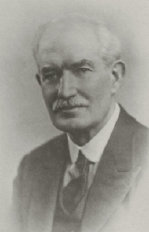
Sir Murdoch MacDonald
(6 May 1866 – 24 April 1957)

Loch Ness "Monster.''
The Central Queensland Herald (Rockhampton, Qld.)
Date: December 14, 1933
Page Number: 16
LONDON has at least heard of the "monster" said to be haunting the waters of Loch Ness, the picturesque stretch which forms part of the Caledonian Canal. Cockney efforts to be funny on the subject are a little heavy. That something unusual has been seen in the loch during the past summer is undoubted, but whether it is anything more than a tree-trunk covered with weeds is open to doubt. Something must be allowed for Highland imaginativeness, as well as Highland fondness for pulling a Lowland leg. Loch Ness is remarkable for the great depth and the icy coldness of its waters, as well as the beauty of its surroundings, and does not need a sea-serpent to add to its attractiveness. The idea that some prehistoric animal may have made its tardy reappearance is, of course, scouted by the experts.

SEASONAL SEA SERPENTS.
Exploding a Myth of the Deeps.
The Central Queensland Herald (Rockhampton, Qld.)
Date: December 14, 1933
Page Number: 16
(By Dr. Antoin Lemaitre, Oceanographer.)
The mystery of the monster of Loch Ness—the 30-foot monster said to have eyes like motor-lamps—remains, so far, unsolved. If my records, extending over nearly half a century are any criterion, the mystery will remain. It always does. For there seems to be a season for sea serpents, as for earthquakes.
About the time that the terrifying giant was reported in those Scottish waters, another nautical survivor of mediaeval legend was terrifying people along the coast of British Columbia. A score of people of undoubted veracity saw a camel-faced green and brown monster playing in the water or scratching its back on the rocks. Originally reported as eighty foot long, its length has now shrunk (in the last reports) to a more reasonable forty feet.
With the classification of existing animal forms nearly complete, scientists can say, with fair certainty, that sea serpents are not land forms. Because they have relatively fewer marine types classified, and particularly a lack of deep-sea specimens, they cannot say definitely whether there are sea serpents or not, even though they may doubt their existence.
Abnormal Visual Conditions.
Abnormal visual conditions, poor observation, ignorance and superstition have explained many sea serpents in the past. One common source of sea serpent stories has been the habit of porpoises swimming one behind the other. Coming up to breathe with their customary regularity, they can, from a distance and in a poor light, give a collective picture of a serpentiform monster moving forward by a series of undulations. Sea fowl or a brood of ducks have been mistaken from a distance for sea serpents swimming on the surface, as have masses of seaweed floating half-submerged. A species of fish, called the basking shark, also starts such stories by swimming in pairs one behind the other, thus giving the appearance of a monster sixty feet long.
There are really large, long fish in the sea that have been mistaken for sea serpents. Those of the Mediterranean Sea usually have turned out to be the ribbon or oar fishes, which occasionally grow twenty or thirty feet long and look like snakes. Still better for mistaken identity are the nemertines, which reach a length of thirty to forty-five feet.
The sea serpents of North America and the British Isles are frequently giant squids, which grow to be fifty feet long. Swimming at the surface with two enormous arms trailing behind, they produce a picture which fits many independent and apparently truthful accounts. These require a cylindrical, flattened head (the posterior end of the squid body) and appendages from the neck and head (lateral fins and mantle). Moreover, they spout water in the descriptions which could come from the squid's syphon.
Another group of stories tells of the diving of whales wherein they go to the bottom and are attacked by the sea serpents. Many accounts tell of whales hopelessly enmeshed in the coils of marine monsters. Probably the reverse is true, and that the whale caught a squid whose tentacles were torn off in the struggle and were coiled around the whale.
"Catch the Serpent First."
Despite all these reasons of explanation, there are still a host of sea serpent reports which do not fit the facts. That is why the reports still appear. Scientists, in the meantime, will say, as they always have: "Maybe so, but you catch the serpent first." For although experienced seamen, like Sir Arthur Rostron, the commodore of the Cunard Fleet, testify to having seen queer monsters with 12 foot necks, and say that no one in this world knows what strange creatures live in the depths of the ocean, we oceanographers know that marine life diminishes as the depth of the sea increases, and that the biggest creatures, like the whale, are much likelier to live near the surface and to show themseves frequently upon it, than to lurk in the depths, appearing so infrequently that each time they do so they are sensational news. The reason for this, of course, is that the pressures at great depths are too great for any bone and muscle framework, no matter how massive, to withstand. If the armour plates of a great submarine start under the pressure at only a few hundred feet, and a diver has to be encased in a huge steel suit to prevent himself from being crushed at 250 feet, imagine the fate of a living monster built even on mastodon lines if it tried to descend to the depths at which legend has it that the mighty sea serpent lurks!

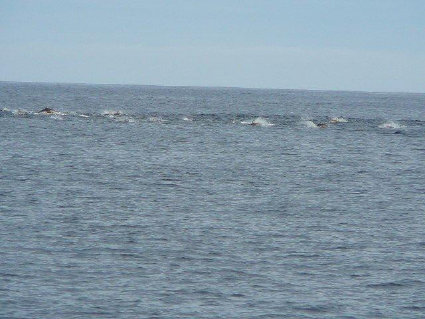
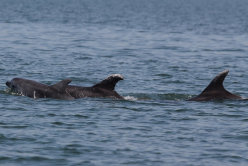
Dolphins swimming in line
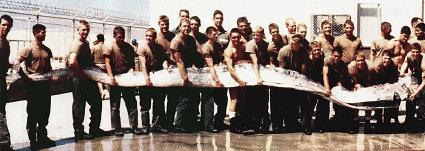

Oarfish
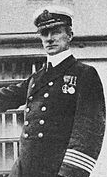

Sir Arthur Henry Rostron,
KBE, RD, RNR
(14 May 1869 – 4 November 1940) was a Captain for the Cunard Line and was the master of the ocean liner RMS Carpathia when it rescued the survivors of the RMS Titanic which sank on 15 April 1912 after striking an iceberg.
In his memoirs Home from the Sea (pps 45-47) Commander Rostron tells how he was acting as Chief Officer on board the Campania [on
April 26, 1907], when something remarkable happened -
“We were coming one Friday evening into Queenstown, when off Galley Head, I
noticed something sticking out of the water. ‘Keep clear of the snag right ahead,’ I called out to the junior officer who was with
me on the bridge. We swung away a point but gradually drew nearer so that we were able to make out what the unusual thing was. It
was a sea monster! It was no more than fifty feet from the ship’s side when we passed it, and so both I and the junior officer had
a good sight of it." SOURCE
JUST WHAT IS THE MONSTER OF LOCH NESS ?
Sunday Times (Perth, WA)
Date: December 17, 1933
Page Number: 3 S
The above, reproduced from a postcard sent from Scotland, shows how photographer and artist have combined to illustrate the stories of the Loch Ness monster which are causing so much discussion in Britain. The photograph is actually one of Lich Ness, with the old castle Urquhart in the right foreground.

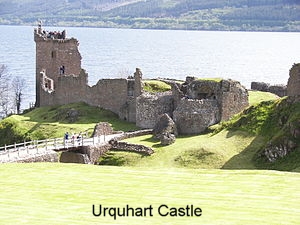

Lich Ness ???
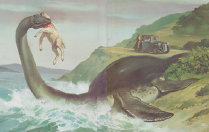
Contents






















